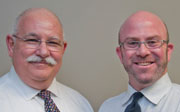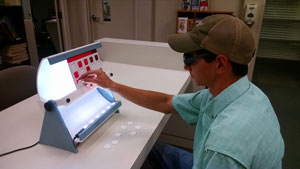 |
Jonathon, an 18-year-old male, was referred by a local pediatric ophthalmologist. The patient had been having headaches, blurry vision at near and intermittent diplopia since first grade. Jonathon and his parents, who had accompanied him to the examination, were seeking a second opinion concerning surgery.
When questioned about previous treatment, Jonathon brought out a most interesting pair of glasses—Ben Franklin style “bifocals” in which each lens was made of two separate lenses of different prism powers. He was wearing a total prism power of 6Δ base in for distance (split 3Δ base in each eye) and 20Δ base in for near (split 10Δ base in each eye) with a +4.00D add!
The power of the prism had increased during the past four years since the pediatric ophthalmologist had referred the patient to an optometrist for prism glasses. After four years of power increases to the Rx, the family recently went back to the surgeon, who responded by saying that he was surprised that the patient had not come back sooner.
They discussed surgery, requested a second opinion and the surgeon referred him to our clinic.
Diagnostic Data
At our examination, Jonathon complained of headaches and blurry vision with near work and diplopia at near greater than distance. The family characterized his learning history as challenging. Reading was especially difficult—he mixed up small words, words ran together and he was seeing double. Mom recalled that she would copy assignments and increase the size of the materials to make it easier for him to read. This brought her to the verge of tears.
Jonathon was not able to keep up in a traditional classroom and was completing high school online. He was planning to attend a technical school in the fall. He had scored a 21 on the ACT (an average score); he knew that his visual issues were holding him back.
When questioned about the use of his glasses, he reported that they were of little help and that he never used them. His habitual spectacle prescription was:
+1.00 DS 3Δ base in at distance, 10Δ base in at near OD
+1.00-0.75 x 90 3Δ base in at distance, 10Δ base in at near OS
+4.00 add OU
His visual acuity was 20/20 OD, OS, OU at distance and 20/30 OD, 20/40 OS at near. Uncorrected acuity was 20/30 OD, OS, OU at distance and 20/100 OD, OS, OU at near. Stereopsis was measured at 25 seconds of arc on Wirt circles, and covert test was 2Δ exophoria at distance and 8Δ intermittent alternating exotropia at near. Near point of convergence was 10cm break and 14cm recovery, performed three times. Accommodative amplitudes were 13D OD and 14D OS. Confrontation fields, pupils and extraocular motilities were normal.
 | |
| Our patient’s glasses had two different prism powers split into each lens. |
Retinoscopy:
OD: +1.75-0.50 x 105
OS: +1.75-0.75 x 055
Subjective refraction:
OD: +1.25-0.50 x 105 20/20
OS: +1.50-0.50 x 055 20/20
With the subjective refraction in place, the near visual acuity was 20/50 OD, OS, OU. Negative relative accommodation (NRA) was +2.00, and positive relative accommodation (PRA) was -0.75. The patient also reported diplopia.
With the subjective refraction in a trial frame, we attempted vergence ranges with a prism bar (which allows greater ability to observe the eyes). In this case, we used bar vergences instead of vergences in the phoropter due to the presence of the exotropia. At distance, the ranges were limited, showing x/6/4 for positive fusional vergence and x/6/1 for negative fusional vergence. At near, the patient was diplopic and required 10Δ base in for fusion.
Diagnosis and Rx
At this point, two things became clear. One, the patient needed plus at near, based on the visual acuity and imbalance of the NRA/PRA. Second, he also needed vision therapy.
 | |
| The patient is now enrolled in a vision therapy program and his symptoms have improved after just six sessions. |
Based on the approximate +0.50D imbalance, we trial framed that amount over the subjective refraction. His visual acuity immediately improved to 20/20 OD, OS, OU. We repeated the cover test at near, and he demonstrated great control with 4Δ of exophoria. After discussing the prescription options, we decided that a full-time prescription with the extra +0.50 was the right choice based on the patient’s future technical trade, patient choice and the fact that when trialed, the patient continued to see 20/20 at distance.
The final prescription for full-time wear was +1.75-0.50 x 105 20/20 OD and +2.00-0.50 x 55 20/20 OS.
We presented the idea of vision therapy to all parties and discussed the potential improvement in symptoms and academic limitations. The parents were shocked to hear about such a treatment and that it was not recently invented. They questioned why Jonathon’s previous doctors had not offered this option and instead allowed him to struggle, prescribing increasing amounts of prism and then turning to surgery to correct this common visual issue. Mom once again started to cry. We felt sorry that their son had struggled for so long, but were confident that with time and commitment, vision therapy along with the appropriate glasses prescription would successfully remediate the condition.
Discussion
A wealth of research directs us to the most appropriate treatment for convergence insufficiency, which affects 3% to 5% of the population.1 In a comparison of base in prism (based on Sheard’s criteria) vs. placebo glasses, base in prism reading glasses were found to be no more effective than placebo in alleviating symptoms, improving the near point of convergence or improving positive fusional vergence at near.2
In a randomized, double-blind, placebo-controlled study that compared office-based vision therapy, office-based sham (placebo) therapy and home-based pencil push-ups (HBPP), office-based vision therapy was more effective than office-based sham (placebo) therapy and home-based pencil push-ups in reducing signs and symptoms of convergence insufficiency.3
A second randomized, double-blind study investigated HBPP, home-based computer vergence/accommodative therapy and pencil push-ups (HBCVAT), office-based vergence/accommodative therapy with home reinforcement (OBVAT) and office-based placebo therapy with home reinforcement (OBPT). This study found a significant difference between the OBVAT treatment and all of the other treatments.4 The research team concluded that 12 weeks of OBVAT compared with HBPP, HBCVAT and OBPT results in significantly greater:
- Improvement in symptoms
- Improvement in near point of convergence
- Improvement in positive fusional vergence
- Percentage of patients reaching the predetermined criteria of success
The “take home” message is that convergence insufficiency is most effectively treated with office-based vision therapy with home-based support. So, if your office does not offer this treatment, refer to a colleague who does. To find an optometrist in your area who offers vision therapy, visit the Optometric Extension Program Foundation (www.oepf.org/page/map) or the College of Optometrists in Vision Development (http://locate.covd.org). No child like Jonathon should be allowed suffer and not reach his true potential. Do not keep vision therapy—the most appropriate treatment for not only convergence insufficiency but also accommodative and ocular motor dysfunction—a hidden gem. It’s time to share the wealth.
1. Scheiman M, Wick B. Clinical Management of Binocular Vision: Heterophoric, Accommodative and Eye Movement Disorders. Philadelphia: Lippincott, Williams & Wilkins; 2008.2. Scheiman M, Cotter S, Rouse M, et al; Convergence Insufficiency Treatment Trial Study Group. Randomised clinical trial of the effectiveness of base-in prism reading glasses versus placebo reading glasses for symptomatic convergence insufficiency in children. Br J Ophthalmol. 2005 Oct;89(10):1318-23.
3. Scheiman M, Mitchell GL, Cotter S, et al; Convergence Insufficiency Treatment Trial Study Group. A randomized clinical trial of treatments for convergence insufficiency in children. Arch Ophthalmol. 2005 Jan;123(1):14-24.
4. Convergence Insufficiency Treatment Trial Study Group. Randomized clinical trial of treatments for symptomatic convergence insufficiency in children. Arch Ophthalmol. 2008 Oct;126(10):1336-49.

